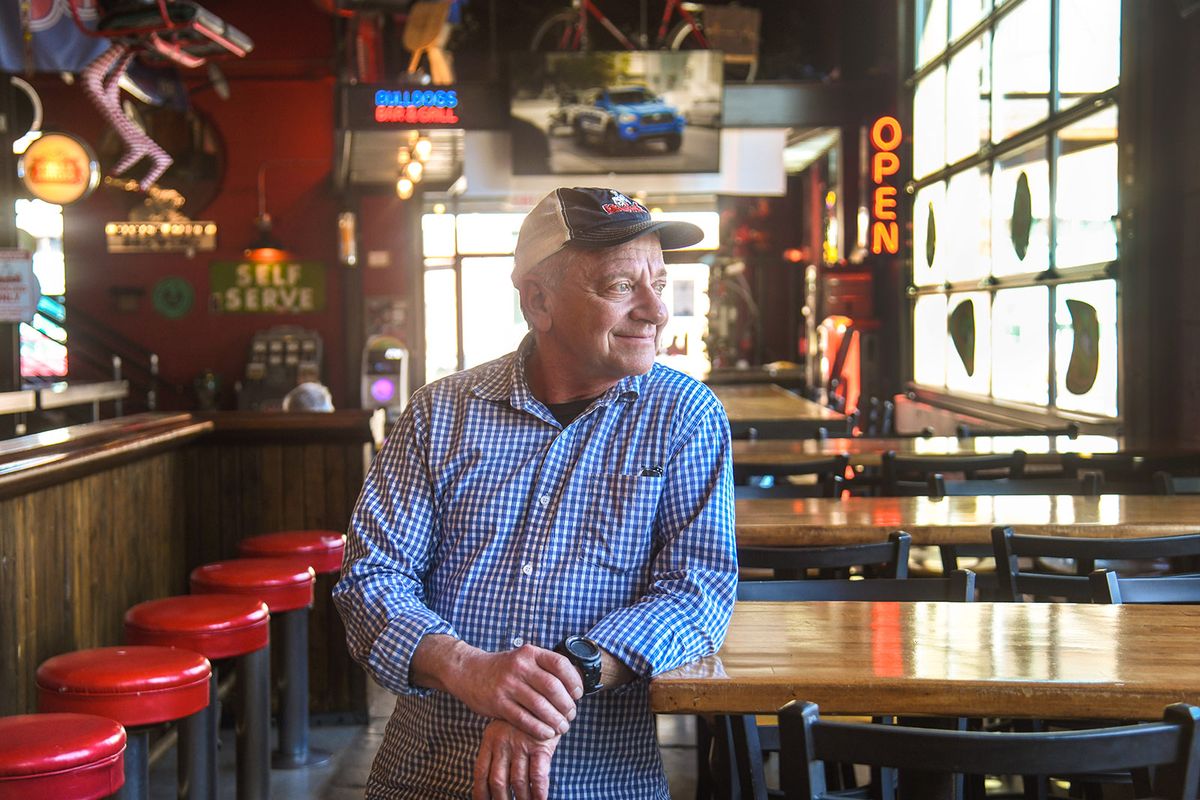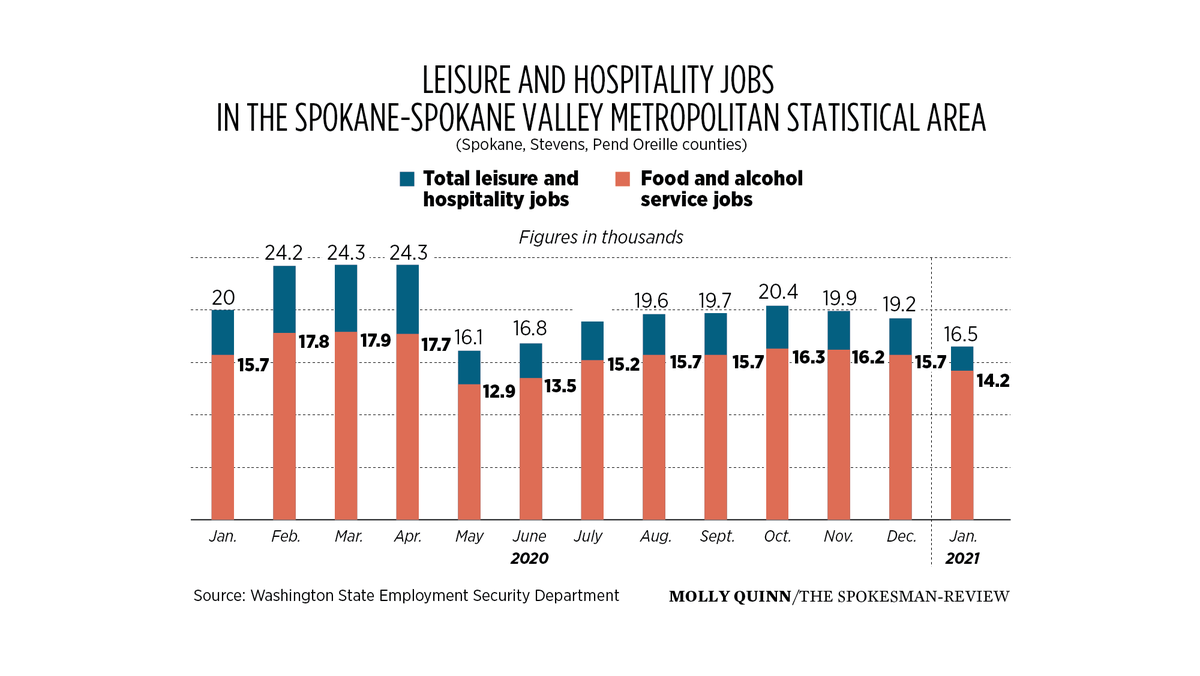Spokane’s restaurant, hospitality industry poised to bounce back after COVID-19’s economic hit
Mark Starr is the owner of David’s Pizza located across from the Spokane Arena at 803 W. Mallon Ave. (DAN PELLE/THE SPOKESMAN-REVIEW)Buy a print of this photo
For David’s Pizza owner Mark Starr, last year was shaping up to be the best in the restaurant’s more than 20-year history with expectations to capture foot traffic from several events planned at the nearby Spokane Arena.
Those expectations came to a screeching halt last March as the coronavirus pandemic took hold in the state, causing cancellation of in-person events and temporary closure of indoor dining at restaurants.
“From then on, it was a downhill slide. We had dozens of catering cancellations for weddings and store openings. Our catering business has been completely shut down,” Starr said. The restaurant, 803 W. Mallon Ave., lost two-thirds of its staff, and revenue dropped 80% from 2019 levels.
Although restaurants were permitted to open indoor dining at 25% capacity in February under statewide Phase 2 guidelines, the road to recovery still is lengthy for David’s Pizza and many others in the region’s food service and hospitality industries.
“Not everybody has been able to make it, and that’s very sad. There are a lot of restaurants and bars that couldn’t weather this storm, and it’s tough,” Starr said. “It’s financially impossible for many people to stay open. It’s all I can do to make our expenses, and I’ve been doing that since November.”
Some 121 restaurants in Spokane County permanently closed during the first six months of the pandemic, according to the Washington Hospitality Association. The association has yet to update data through the end of 2020.
Among those closures were Prospector’s Bar & Grill in north Spokane; Timber Creek Buffet and Players & Spectators in Spokane Valley; Wolffy’s Hamburgers and Geno’s near Gonzaga University; and downtown Spokane restaurants Rocky Rococo, which had been in operation for more than 35 years, and Tomato Street’s second Spokane location.
Other restaurants that shuttered – although not entirely because of COVID-19’s impact – included the Lantern Tap House in the Perry District as well as Central Food and Wandering Table in Kendall Yards. New owners, however, plan to reopen a tap house in the space formerly occupied by the Lantern later this year, and Geno’s already has reopened as a second location for Cascadia Public House.
In January 2020, about 24,200 people were employed in the leisure and hospitality industry in the region that includes Spokane, Stevens and Pend Oreille counties. By December, that number had fallen to 16,500, according to nonseasonally adjusted data from the Washington State Employment Security Department.
The food services and drinking places sector had 17,800 workers in January 2020, compared to 14,200 in December – a loss of 3,600 jobs, according to the state.
Overall, state data shows Spokane, Stevens and Pend Oreille counties lost 24,203 jobs from January 2020 to December.
Nationally, 4 in 10 of jobs lost since February 2020 were in the leisure and hospitality industry, according to the U.S. Department of Labor’s most recent jobs report.
The pandemic forced many businesses to make the difficult decision to lay off employees because of fewer customers and indoor dining restrictions.
Boots Bakery & Lounge, 24 W. Main Ave., laid off 18 people at the beginning of the state’s stay-home order.
Owner Alison Collins, her husband, Arden, and their two daughters operated the restaurant for several months into the pandemic – a decision that was driven by many factors, Collins said.
“We didn’t want staff to get exposed or get sick, and we were certain and sure we could keep ourselves as safe as possible,” she said, adding the couple was working up to 18 hours a day. “That was very rough for us as a family because the four of us were doing everything, and that was hard.”
Since then, Boots Bakery has rehired three employees with a fourth person who comes in to assist with baking as needed.
Some former employees either chose not to return for safety reasons, or they moved out of the area. Some people have chosen to leave the restaurant industry altogether, Collins said.
Boots Bakery, which is open for takeout, delivery and patio dining, is keeping indoor dining closed until later phases of the state’s COVID-19 recovery plan, as the vegan restaurant can only accommodate 10 people at 25% capacity.
The state will enter Phase 3 of its COVID-19 recovery plan Monday, allowing restaurants to raise indoor dining to 50% capacity.
“We could totally rehab the inside to make it work, but it wouldn’t look good and it wouldn’t be Boots … maybe we’ll open at 50%,” Collins said. “That seems a little more doable to have 20 people in here and make it work.”
Rebuilding an industry
As travelers postponed vacations and meeting planners canceled events in response to the coronavirus pandemic, it significantly impacted Spokane’s tourism industry.
Before the pandemic, the Spokane area in 2019 experienced its best convention year in history, drawing 86 groups to the area and generating 77,225 room nights, according to Visit Spokane, the region’s destination marketing organization.
Visit Spokane reported 89 conferences and events were canceled in 2020, resulting in $56.4 million in lost tourism revenue.
In Spokane County, the average hotel occupancy rate was 43.5% in 2020, compared to 68% in 2019. Average occupancy at downtown Spokane hotels dropped to 34.2% last year, compared to 66.9% in 2019, according to Visit Spokane.
Spokane Hotel Motel Association President Julie Cohen said while tourism has picked up, the hotel industry is in a “rebuilding mode.”
“We’re in a building process. We have to rebuild our industry,” said Cohen, who is also regional general manager of the Holiday Inn Express Downtown Spokane/Sterling Hospitality.
Part of rebuilding the hotel industry involves generating additional business and figuring out how to regain corporate guests, some of whom aren’t traveling as frequently with the increase in telecommuting and virtual meetings.
“Hotels – especially in the downtown Spokane market – bank on the conventions, citywide events and corporate guests,” she said. “Corporate travel is huge in this area. Corporate people aren’t traveling like they used to. We’ve had to look how to get other business to replace that.”
Although data suggests thousands of job losses in the hospitality industry, Cohen said many hotels are struggling with finding employees because of they are concerned about working with the public during the pandemic or they’ve found other lines of work.
Despite challenges related to finding employees and generating new business, recovery of the region’s hospitality industry is gaining momentum, Cohen said, adding she was able to bring back staff members laid off last year.
“We’re moving in the right direction,” she said. “It’s just going to be a lot slower.”
Hopeful for the future
Although the pandemic hit the region harder than the Great Recession – which lasted about two years in Spokane and brought an 11.3% unemployment rate at its height in March 2010 – the economic recovery is anticipated to be faster, economists say.
The Spokane region’s unemployment rate skyrocketed to 16.7% in May and nearly 43,000 people were without jobs. The area’s unemployment rate dropped to 7.4% by February – the most recent data available from the state Employment Security Department .
“It took us almost seven years to recover from the Great Recession, but we’ve already started to recover from the pandemic in just a few months,” said Doug Tweedy, a regional economist for the ESD.
Part of what has helped Spokane’s recovery is its diverse industries, he added.
“A lot of our job base was considered essential, so it didn’t get impacted as hard as other urban counties that didn’t have the same mix as we have,” Tweedy said. “Spokane is a true regional hub, so people come here from Eastern Washington and northern Idaho. Rural counties did fairly well. They were impacted but got through their restrictions earlier than urban counties did.”
Because most of the Spokane area’s employers are smaller compared with large metro areas such as Seattle, they were able to adapt faster over the past year, Tweedy said.
“They had 12 months to look at the changing markets and gained some experience, so I think that speaks well for the future – that these companies know how to survive in their markets even during the pandemic,” Tweedy said.
The “2021 Business in the Northwest” report by Washington State University’s Carson College of Business found 75% of business leaders and employees indicated the pandemic has negatively impacted their companies, but most are cautiously optimistic for the future despite restrictions on in-person gatherings, uncertainty and business closures.
The report surveyed more than 1,050 business leaders and employees in the Pacific Northwest from December 2020 to January.
“In 2020, businesses across the world were presented with unforeseen challenges, from keeping their customers and employees safe to reconfiguring operations amid ever-changing regulations,” Chip Hunter, dean of WSU’s Carson College of Business, said in a statement. “In the Pacific Northwest, finding new ways to adapt has been key in maintaining optimism for the future.”
Data from STR Inc., a global hospitality data and analytics company, shows that Spokane fared slightly better in tourism activity than Seattle, which had an average occupancy rate of 37.9% in 2020.
Jamie Rand, Visit Spokane chief marketing officer, anticipates a resurgence in travel and believes Spokane will continue to fare well compared with other markets in part because of its abundance of outdoor activities and growing nationwide recognition.
Spokane is about a year ahead of what the organization thought it would be in terms of tourism recovery, with 2022 anticipated to be a record-breaking year for conventions, Rand said.
“We are expecting leisure visitors to return in June and July of this year and expect convention travelers to come back by 2022,” Rand said.
Visit Spokane reports some 37,489 room nights were rescheduled to future years with 9,459 of those nights on the books for 2022.
Visit Spokane found that visits to golf courses, state parks and ski resorts in the region significantly increased in 2020. As a result, the organization is embarking on a campaign this year to market the area’s outdoor activities.
Cohen, of the Spokane Hotel Motel Association, also is preparing for what she anticipates will be a busy summer.
“We are starting to see upticks in reservations, and people are traveling absolutely more than what we saw in May of last year,” she said.
Starr, of David’s Pizza, said the state’s decision to increase indoor dining capacity to 50% is a step that will allow him to sustain operations and potentially rehire employees.
“As a community of restaurants and bars, we’ve been staying open to give people places to go, but we’ve been doing so at a loss,” he said. “We’ll at least be able to break even, and that will go a long way to keep us in business.”
Starr is optimistic that Spokane’s hospitality and tourism industry will rebound with plans for several events and completion of The Podium in downtown Spokane later this year.
He’s also looking forward to more customers dining in at the restaurant.
“Being able to put smiles on peoples’ faces – that has kept us going, and just the promise of better days ahead,” Starr said. “Everybody needs to keep a smile and keep encouraging their favorite retailer – whether it’s a bar, restaurant or bookstore. One of the ways they can do that is to get out and shop. I encourage people to continue to support (local businesses), and we’re going to get through this.”

